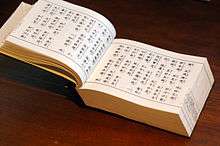Amitabha Sutra

| Part of a series on |
| Mahāyāna Buddhism |
|---|
 |
|
Teachings |
|
Mahāyāna schools |
|
|
The Amitābha Sūtra (traditional Chinese: 阿彌陀經; pinyin: Āmítuó Jīng; Japanese: 阿弥陀経; Vietnamese: A di đà kinh) is a popular colloquial name for the Shorter Sukhāvatīvyūha Sūtra. The Amitābha Sūtra is a Mahayana sutra and is one of the three primary texts of Pure Land Buddhism, along with the Infinite Life Sutra and the Amitayurdhyana Sutra.
History
The Amitābha Sūtra was translated from Sanskrit into Classical Chinese by Tripiṭaka master Kumārajīva in 402, but may have existed in India as early as the year 100 in a Prakrit.[1]
Content
The bulk of the Amitābha Sūtra, considerably shorter than other Pure Land sutras, consists of a discourse which Gautama Buddha gave at Jetavana in Śrāvastī to his disciple Śāriputra. The talk concerned the wondrous adornments that await the righteous in the western pure land of Sukhāvatī as well as the beings that reside there, including the buddha Amitābha. The text also describes what one must do to be reborn there.
In Buddhist traditions
In Pure Land and Chan Buddhism, the sutra is often recited as part of the evening service (Chinese: 晚課; pinyin: wǎnkè), and is also recited as practice for practitioners. The Jōdo shū and Jōdo Shinshū also recite this sutra when necessary. It is frequently recited at Chinese, Japanese and Vietnamese Buddhist funeral services in the hope that the merit generated by reciting the sutra may be transmitted to the departed.
A common format for the recitation of the Amitābha Sūtra in the Chinese tradition may include some or all of the following:
- Praise for the Incense Offering (盧香讚)
- Praise to the Lotus Pond (蓮池讚)
- The Amitābha Sūtra (阿彌陀經)
- Pure Land Rebirth dhāraṇī (往生咒).
- Amitābha Gāthā (彌陀偈)
- Recitation of Amitābha Buddha's Name (佛號)
- Transfer of Merit (迴向)
Mantras
In the Taishō Tripiṭaka, the Amitābha Sūtra is preceded by the Pure Land Rebirth Dhāraṇī:
- namo amitābhāya tathāgatāya tadyathā
- amṛtabhave amṛtasaṃbhave
- amṛtavikrānte amṛtavikrāntagāmini
- gagana kīrtīchare svāhā
See also
- Infinite Life Sutra (Longer Sukhāvatīvyūha Sūtra)
- Amitayurdhyana Sutra (Amitāyus Meditation Sūtra)
- Pure Land Buddhism
- Sukhavati
- Amitābha
References
- ↑ Thích 2003, pp. 11-12.
Bibliography
- Inagaki, Hisao; Stewart, Harold (2003). The Three Pure Land Sutras (PDF). Berkeley, CA: Numata Center for Buddhist Translation and Research. pp. 89–96. ISBN 1-886439-18-4.
- Müller, F. Max (1894). Buddhist Mahâyâna texts, Vol.2. Oxford: Clarendon Press. pp. 87–104. (translation from the Sanskrit MS)
- Shih, Hsuan Hua (2013). The Buddha Speaks of Amitabha Sutra: A General Explanation. ISBN 978-1-60103-029-0.
- Thích, Nhất Hạnh (2003). Finding Our True Home: Living in the Pure Land Here and Now. Parallax Press. ISBN 978-1-888375-34-3.
External links
| Wikisource has original text related to this article: |
- The Shorter Sukhāvatīvyūha Sūtra. Lapis Lazuli Texts.
- The Smaller Sukhavativyuha Sutra, translated by Nishu Utsuki
- English translation of the Amitabha Sutra
- Chinese / English bilingual version of the Amitabha Sutra